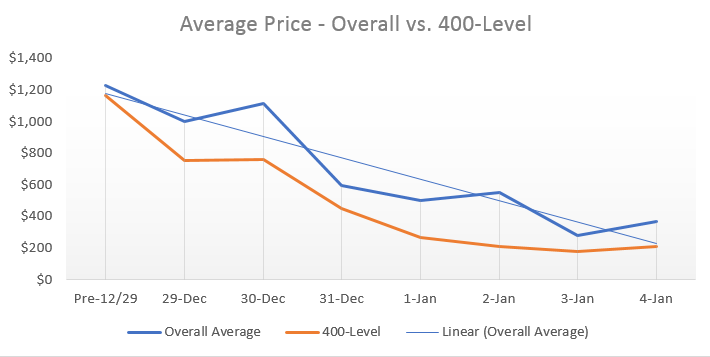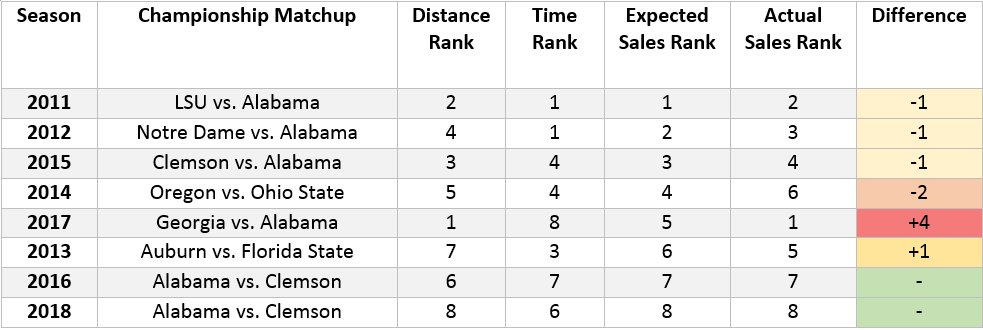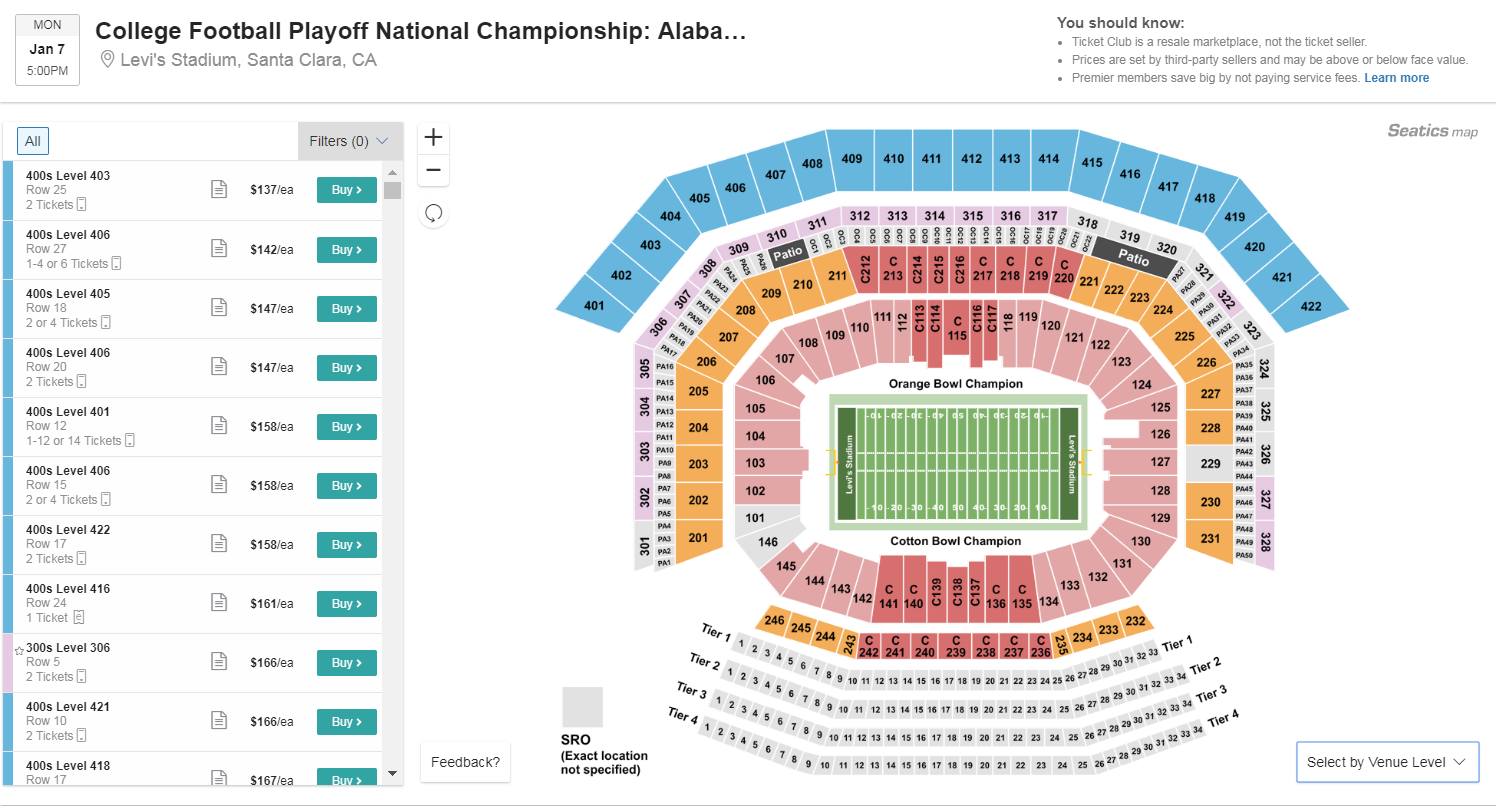There’s a blizzard of headlines going throughout the sports world this week about the upcoming College Football Playoff National Championship game between Alabama and Clemson, and how poorly it is selling. But if you look at the data regarding two key facts on the recent history of games that had college football’s crown on the line, the ticket prices should really come as no surprise.
Currently, the get-in price for the game, which kicks off on Monday evening at Levi’s Stadium south of San Francisco, is down all the way to $137 per ticket, which will score you a spot in Section 406, Row 27. There are tickets in the 300-level for under $200 as well, facts which led to Ticketmaster dropping its price floor on the event to compete with the secondary ticket market.
Alabama-Clemson tickets have been trending sharply downward since last week, starting at over $1,000 per seat prior to the semifinal bowls on December 29 all the way down to around $300 in the past two days. Average prices for 400-level seats (AKA ‘nosebleeds’) were below $200 on Thursday and are just over that line Friday, three days before kickoff.

What’s to blame?
The media speculation has centered on two core themes hypothesizing why sales are so sluggish and the market is so low. First, the game is being played in northern California, far from the sport’s traditional base in the Southeast. Levi’s Stadium is new, state-of-the-art, and regularly hosts major competitions including the San Francisco 49ers home games and the Pac-12 Championship (as well as Super Bowl 50 in 2016). But it has well-known traffic issues, and travel to and from is expensive and not terribly convenient. Second, the semifinals saw Alabama and Clemson advance – A matchup that has occurred three times in the five years since the playoff system was established to replace the BCS final. The Crimson Tide have played in an astonishing six of the previous eight games that decided the champion of DI college football.
To better assess what’s really going on, we took a look at the data over championship games in college football dating back to the 2011 LSU-Alabama tilt, and found that there seem to be two key factors – travel distance for fans, and time between the game’s participants being decided and the game itself.
DISTANCE
Measuring the distance in miles for the fan bases hoping to catch their team winning it all in person, we find that there’s a strong correlation with ticket price. The record-shattering prices seen for last year’s Georgia vs. Alabama title game came with the finale being played at Mercedez-Bend Stadium in Atlanta – the capitol of one of the states that had its flagship university participating, and just over 200 miles from the home stadium of the other. The No. 2 highest price in recent history was 2011’s tilt between Alabama and LSU in New Orleans – another time where a state’s flagship university was playing in a title game within its borders.
This year’s final sees the furthest average distance on record, with Alabama and Clemson’s home stadiums are just shy of 2,500 miles away from Santa Clara.
This chart lists championship games sorted by average distance between the game location and the home field of each team:

TIME
Prior to the College Football Playoff, the BCS would announce its title game participants in early December, following the outcome of the various conference championship games. That left the better part of a month (or more) between when fan bases knew where their teams would be playing, and the games themselves. In the five years of CFP action, that championship game has followed semifinals played in a span as short as a week.
That 2011 LSU-Alabama game and the 2012 Notre Dame-Alabama game both saw over 30 days for fans to plan on their travel expense (or for LSU fans, to save up for snacks at the game, presumably). Both saw prices well over $1000 on average. The obvious outlier here is the 2017 title game, where just seven days elapsed between Georgia and Alabama’s semifinal victory and the championship – yet prices set the record on the secondary market. But given that neither fan group (at least those living local to their chosen school) necessarily needed to factor airfare or even hotels into their cost, it makes sense why that one might have been fine for the quick turnaround.
This chart is sorted by the time fans had between the game’s participants being decided, and kickoff:

Predicted Prices vs. Reality
If we use these two data points, how well could we assume an average ticket price based on those factors alone? As it happens, pretty well, save for the Georgia-Alabama outlier from one year ago. Weighing distance as the more important factor, only two games are more than one spot off of an ‘expected’ average price rank compared to their actual one.
As the data shows, the 2018 final between Clemson and Alabama is a bit of a perfect storm – it is the furthest distance for fans to travel, and there was limited time between contests to arrange for travel, should those interested in attending the game actually have the means to do so in the first place. Couple those facts with fan bases who have had repeated chances to see their teams play for a title, including against each other in three of the past four seasons, and here we are.

What Does This Mean for the Future?
Currently, CFP championship games are scheduled through 2023. Next year, the game will return to New Orleans. In 2020, Miami will host, followed in subsequent seasons by Indianapolis, Los Angeles, and Houston. Given that the time between semifinals and finals isn’t going to change much over the next five years, it’s likely that officials related to any of those contests will have a strong rooting interest for whichever team has its fan base closest as the semifinal pairings are being figured out.
Current CFP Championship Ticket Prices
Note: Maximum numbers are skewed by some ticket groups listed far above what anyone might actually pay, presumably priced by brokers waiting to see if prices rebound closer to game time.


